Trace Analysis for the Food Industry
Trace Analysis for the Food Industry
TXRF (Total Reflection X-Ray Fluorescence spectrometry) delivers multi-element trace analysis, with detection limits in the ppb and ppm range. The technique is extremely flexible and can be used in a variety of industries, including food and beverage analysis.
Read on for more specific food industry applications; Blue Scientific is the exclusive UK distributor for Bruker TXRF, and we are available to answer all your questions. Just get in touch on 01223 422 269 or info@blue-scientific.com
Come to our Workshop!
Try TXRF trace analysis using your own samples at our workshop in Cambridge on Tuesday 13th October. Meet a TXRF applications scientist from Bruker, hear talks about the theory and practice of TXRF and have all your questions answered. Spaces are limited so registration is required – click here for full details and online registration.
Food Industry Applications
TXRF is extremely flexible, so if your food application is not mentioned here, please contact us on 01223 422 269 or info@blue-scientific.com.

Meat and Fish
Screen meat and fish for macro and trace elements relevant to nutrition, including Na, Mg, K, Ca, Ti, V, Cr and more. Read the lab report
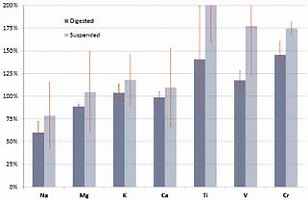
Recovery of light elements (Na to Cr) in fish and vertebrate samples using the S2 PICOFOX
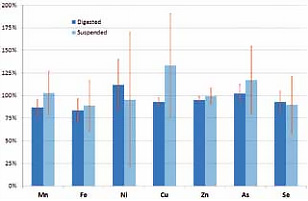
Recovery of metals (Mn to Se) in fish and vertebrate samples using the S2 PICOFOX
[hr]

Fruit, Vegetables, Salad and Plant Materials
Analysis of trace elements in plant material provides important information:
- Detect heavy metals and other toxic elements, which can accumulate in plants and enter the food chain.
- Control essential macro (eg Mg, P, K, Ca) and trace elements (eg Fe, Zn) with respect to nutrition and the fertilisation of agricultural plants.
- Screen for illegal application of pesticides and adulterates during food production, indicated by abnormally high Br and Cl levels.
The most common analytical techniques for macro and trace element analysis are ICP-OES (inductively-coupled plasma optical emission spectroscopy) and ICP-MS (inductively coupled plasma mass spectroscopy). However, with these techniques the organic matrix of plant materials can cause analytical bias and cause blockages if not fully dissolved. They also involve laborious and time-consuming procedures for decomposition and digestion. Sample preparation for TXRF is much faster and simpler. By preparing a suspension after grinding, time-consuming digestion can be avoided.
TXRF spectroscopy is a fast, economical alternative or complementary analytical technique for raw materials and finished products in food processing.
Read a lab report using certified reference materials from apple, peach, citrus and tomato plants.
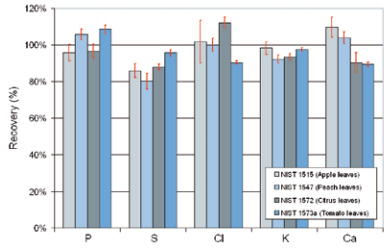
Recovery of macronutrients in different plant standards using the Bruker S2 PICOFOX TXRF (red bars indicate standard deviation)
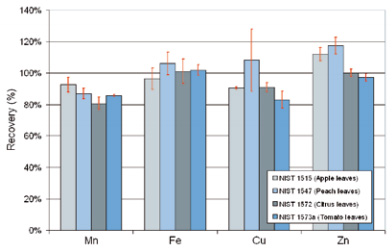
Recovery of micronutrients in different plant standards using the Bruker S2 PICOFOX TXRF (red bars indicate standard deviation)
[hr]

Drinks / Beverages
Detect trace and harmful elements such as mercury, to ensure consumer safety and comply with regulations. The low threshold values of European regulations requires extremely sensitive analysis for Hg detection and measurement.
The most common methods are CV-AAS (cold vapor atomic adsorption spectroscopy) and ICP-MS (inductively coupled plasma mass spectroscopy). These techniques are highly sensitive, but are also time-consuming and have high operating costs, with sample preparation techniques that often involve hazardous chemicals. TXRF is much faster and more economical, with simple and fast sample preparation.
TXRF is an ideal supplementary tool to alternative methods, for fast, multi-element trace analysis in beverages. Read a lab report about detecting mercury in tap water, orange juice or wine.
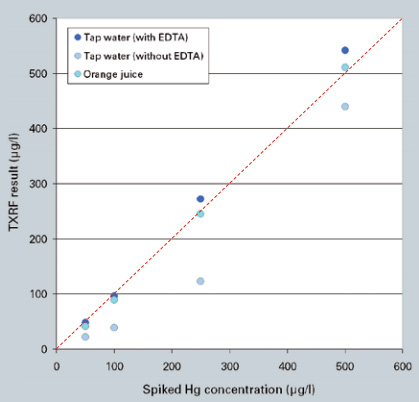
Comparison of spiked and measured mercury values in tap water and orange juice using the Bruker S2 PICOFOX TXRF
[hr]
Liquid Nutritional Products and Milk Powder
Liquid nutritional products (LNP) are nutritionally supplemented for patients who are recovering from illness, injury or surgery and for people at risk of malnutrition. As well as a broad range of vitamins, proteins, lipids and carbohydrates, they contain minerals:
- Macro-nutrients Na, Mg, P, K, Ca, Mn, Fe, Cu and Zn (concentration range: mg/100g)
- Micro-nutrients as fortifiers Cr, Se, Mo and I (concentration range µg/100g)
Analysing these minerals is important for product compliance and quality control. TXRF is ideal for rapid multi-element quantification of macro and micro-nutrients in LNP, with quick and easy sample preparation.
[hr]

